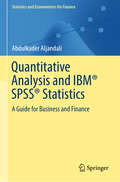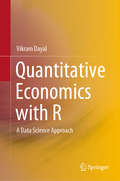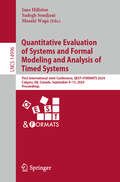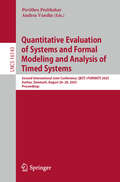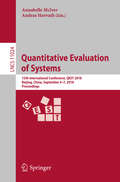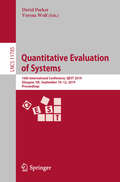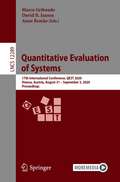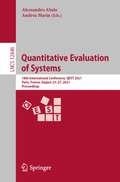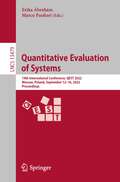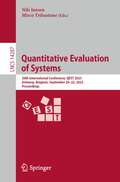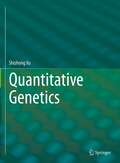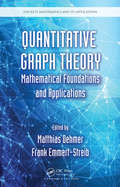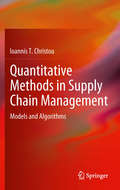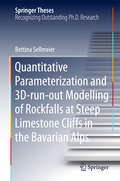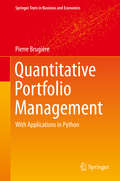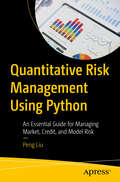- Table View
- List View
Quantitative Analysis and IBM® SPSS® Statistics: A Guide for Business and Finance (Statistics and Econometrics for Finance)
by Abdulkader AljandaliThis guide is for practicing statisticians and data scientists who use IBM SPSS for statistical analysis of big data in business and finance. This is the first of a two-part guide to SPSS for Windows, introducing data entry into SPSS, along with elementary statistical and graphical methods for summarizing and presenting data. Part I also covers the rudiments of hypothesis testing and business forecasting while Part II will present multivariate statistical methods, more advanced forecasting methods, and multivariate methods. IBM SPSS Statistics offers a powerful set of statistical and information analysis systems that run on a wide variety of personal computers. The software is built around routines that have been developed, tested, and widely used for more than 20 years. As such, IBM SPSS Statistics is extensively used in industry, commerce, banking, local and national governments, and education. Just a small subset of users of the package include the major clearing banks, the BBC, British Gas, British Airways, British Telecom, the Consumer Association, Eurotunnel, GSK, TfL, the NHS, Shell, Unilever, and W.H.S. Although the emphasis in this guide is on applications of IBM SPSS Statistics, there is a need for users to be aware of the statistical assumptions and rationales underpinning correct and meaningful application of the techniques available in the package; therefore, such assumptions are discussed, and methods of assessing their validity are described. Also presented is the logic underlying the computation of the more commonly used test statistics in the area of hypothesis testing. Mathematical background is kept to a minimum.
Quantitative Biology: A Practical Introduction (Learning Materials in Biosciences)
by Akatsuki KimuraThis textbook is for biologists, to conduct quantitative analysis and modeling of biological processes at molecular and cellular levels. Focusing on practical concepts and techniques for everyday research, this text will enable beginners, both students and established biologists, to take the first step in quantitative biology. It also provides step-by-step tutorials to run various sample programs in one’s personal computer using Excel and Python. This volume traces topics, starting with an introductory chapter, such as modeling, construction and execution of numerical models, and key concepts in quantitative biology: feedback regulations, fluctuations and randomness, and statistical analyses. It also provide sample codes with guidance to procedure programming for actual biological processes such as movement of the nucleus within a cell, cell-cycle regulation, stripe pattern formation of skins, and distribution of energy. Written by a leading research scientist who has a background in biology, studied quantitative approaches by himself, and teaches quantitative biology at several universities, this textbook broadens quantitative approaches for biologists who do not have a strong background in mathematics, physics, or computer programming, and helps them progress further in their research.
Quantitative Economics with R: A Data Science Approach
by Vikram DayalThis book provides a contemporary treatment of quantitative economics, with a focus on data science. The book introduces the reader to R and RStudio, and uses expert Hadley Wickham’s tidyverse package for different parts of the data analysis workflow. After a gentle introduction to R code, the reader’s R skills are gradually honed, with the help of “your turn” exercises. At the heart of data science is data, and the book equips the reader to import and wrangle data, (including network data). Very early on, the reader will begin using the popular ggplot2 package for visualizing data, even making basic maps. The use of R in understanding functions, simulating difference equations, and carrying out matrix operations is also covered. The book uses Monte Carlo simulation to understand probability and statistical inference, and the bootstrap is introduced. Causal inference is illuminated using simulation, data graphs, and R code for applications with real economic examples, covering experiments, matching, regression discontinuity, difference-in-difference, and instrumental variables. The interplay of growth related data and models is presented, before the book introduces the reader to time series data analysis with graphs, simulation, and examples. Lastly, two computationally intensive methods—generalized additive models and random forests (an important and versatile machine learning method)—are introduced intuitively with applications. The book will be of great interest to economists—students, teachers, and researchers alike—who want to learn R. It will help economics students gain an intuitive appreciation of applied economics and enjoy engaging with the material actively, while also equipping them with key data science skills.
Quantitative Elements of General Biology: A Dynamical Systems Approach
by Ivan MalyThis monograph sketches out a broad spectrum of problems (from evolution and metabolism to morphogenesis and biogeographical dynamics) whose solution has been impacted by mathematical models. Each of the selected examples has led to the recognition—and set direction to further study—of certain fundamental but unintuitive properties of biological systems, such as the making and breaking of specific symmetries that underlie morphogenesis. Whether they are long-established or only recently accepted, these models are selected for being thought-provoking and illuminating both the achievements and the gaps in our current understanding of the given area of biology. The selection of models is also meant to bring to the fore the existing degree of unity in the quantitative approach to diverse general-biological questions and in the systems-level properties that are discovered across the levels of biological organization. It is the thesis of this book that further cultivation of such unity is a way forward as we progress toward a general theory of living matter.This is an ideal book for students (in the broadest sense) of biology who wish to learn from this attempt to present the exemplary models, their methodological lessons, and the outline of a unified theory of living matter that is now beginning to emerge. In addition to a doctoral student preparing for quantitative biology research, this reader could also be an interdisciplinary scientist transitioning to biology. The latter—for example, a physicist or an engineer—may be comfortable with the mathematical apparatus and prepared to quickly enter the intended area of work, but desires a broader foundation in biology from the quantitative perspective.
Quantitative Evaluation of Systems and Formal Modeling and Analysis of Timed Systems: First International Joint Conference, QEST+FORMATS 2024, Calgary, AB, Canada, September 9–13, 2024, Proceedings (Lecture Notes in Computer Science #14996)
by Jane Hillston Sadegh Soudjani Masaki WagaThis book constitutes the proceedings of the First International Joint Conference on Quantitative Evaluation of Systems and Formal Modeling and Analysis of Timed Systems, QEST+Formats 2024, which took place in Calgary, AB, Canada, during September 2024. This year the 21th International Conference on Quantitative Evaluation of SysTems (QEST 2024) and the 22nd International Conference on Formal Modeling and Analysis of Timed Systems (FORMATS 2024) joint forces and took place as part of the CONFEST 2024 umbrella conference. The 19 full papers presented in this book were carefully reviewed and selected from 33 submissions. They deal with up-to-date topics in quantitative evaluation and verification of systems, focusing on fundamental and practical aspects of systems with quantitative nature, such as probability, timing, and cost, and modeling, design and analysis of computational systems.
Quantitative Evaluation of Systems and Formal Modeling and Analysis of Timed Systems: Second International Joint Conference, QEST+FORMATS 2025, Aarhus, Denmark, August 26–28, 2025, Proceedings (Lecture Notes in Computer Science #16143)
by Pavithra Prabhakar Andrea VandinThis book constitutes the proceedings of the Second International Joint Conference on Quantitative Evaluation of Systems and Formal Modeling and Analysis of Timed Systems, QEST+Formats 2025, which took place in Aarhus, Denmark, during August 2025. The 26 full papers included in these proceedings were carefully reviewed and selected from 57 submissions. They focus on up to date research in quantitative evaluation of systems and formal modeling and analysis of timed systems.
Quantitative Evaluation of Systems: 15th International Conference, QEST 2018, Beijing, China, September 4-7, 2018, Proceedings (Lecture Notes in Computer Science #11024)
by Annabelle McIver Andras HorvathThis book constitutes the proceedings of the 15th International Conference on Quantitative Evaluation Systems, QEST 2018, held in Beijing, China, in September 2018. The 24 full papers presented were carefully reviewed and selected from 51 submissions. The papers cover topics in the field of quantitative evaluation and verification of computer systems and networks through stochastic models and measurements emphasizing two frontier topics in research: quantitative information flow for security and industrial formal methods.
Quantitative Evaluation of Systems: 16th International Conference, QEST 2019, Glasgow, UK, September 10–12, 2019, Proceedings (Lecture Notes in Computer Science #11785)
by David Parker Verena WolfThis book constitutes the proceedings of the 16th International Conference on Quantitative Evaluation Systems, QEST 2019, held in Glasgow, UK, in September 2019.The 17 full papers presented together with 2 short papers were carefully reviewed and selected from 40 submissions. The papers cover topics in the field of Probabilistic Verification; Learning and Verification; Hybrid Systems; Security; Probabilistic Modelling and Abstraction; and Applications and Tools.
Quantitative Evaluation of Systems: 17th International Conference, QEST 2020, Vienna, Austria, August 31 – September 3, 2020, Proceedings (Lecture Notes in Computer Science #12289)
by Marco Gribaudo Anne Remke David N. JansenThis book constitutes the proceedings of the 17th International Conference on Quantitative Evaluation Systems, QEST 2020, held in Vienna, Austria, in August/September 2020. The 12 full papers presented together with 7 short papers were carefully reviewed and selected from 42 submissions. The papers cover topics such as classic measures involving performance and reliability, quantification of properties that are classically qualitative, such as safety, correctness, and security as well as analytic studies, diversity in the model formalisms and methodologies employed, and development of new formalisms and methodologies.
Quantitative Evaluation of Systems: 18th International Conference, QEST 2021, Paris, France, August 23–27, 2021, Proceedings (Lecture Notes in Computer Science #12846)
by Alessandro Abate Andrea MarinThis book constitutes the proceedings of the 18th International Conference on Quantitative Evaluation Systems, QEST 2021, held in Paris, France, in August 2021.The 21 full papers and 2 short papers presented together with 2 keynote papers were carefully reviewed and selected from 47 submissions. The papers are organized in the following topics: probabilistic model checking; quantitative models and metamodels: analysis and validation; queueing systems; learning and verification; simulation; performance evaluation; abstractions and aggregations; and stochastic models.
Quantitative Evaluation of Systems: 19th International Conference, QEST 2022, Warsaw, Poland, September 12–16, 2022, Proceedings (Lecture Notes in Computer Science #13479)
by Erika Ábrahám Marco PaolieriThis book constitutes the proceedings of the 19th International Conference on Quantitative Evaluation Systems, QEST 2022, held in Warsaw, Poland, in September 2022.The 19 full papers presented together with 1 keynote paper were carefully reviewed and selected from 44 submissions. The papers are organized in the following topics: program analysis; parameter synthesis; markovian agents and population models; dynamical systems; tools; applications and automata theory; and applications.
Quantitative Evaluation of Systems: 20th International Conference, QEST 2023, Antwerp, Belgium, September 20–22, 2023, Proceedings (Lecture Notes in Computer Science #14287)
by Nils Jansen Mirco TribastoneThis book constitutes the proceedings of the 20th International Conference on Quantitative Evaluation of Systems, QEST 2023, which took place in Antwerp, Belgium, in September 2023. The 23 papers included in this book were carefully reviewed and selected from 44 submissions. They deal with current topics in quantitative evaluation and verification of computer systems and networks, focusing on data-driven and machine-learning systems, case studies, and tool papers. The book also contains the extended abstract of the invited talk from David Parker.
Quantitative Genetics
by Shizhong XuThe intended audience of this textbook are plant and animal breeders, upper-level undergraduate and graduate students in biological and agricultural science majors. Statisticians who are interested in understanding how statistical methods are applied to genetics and agriculture can benefit substantially by reading this book. One characteristic of this textbook is represented by three chapters of technical reviews for Mendelian genetics, population genetics and preliminary statistics, which are prerequisites for studying quantitative genetics. Numerous examples are provided to illustrate different methods of data analysis and estimation of genetic parameters. Along with each example of data analyses is the program code of SAS (statistical analysis system).
Quantitative Graph Theory: Mathematical Foundations and Applications
by Matthias Dehmer Frank Emmert-StreibThe first book devoted exclusively to quantitative graph theory, Quantitative Graph Theory: Mathematical Foundations and Applications presents and demonstrates existing and novel methods for analyzing graphs quantitatively. Incorporating interdisciplinary knowledge from graph theory, information theory, measurement theory, and statistical technique
Quantitative Logic and Soft Computing 2016
by Tai-He Fan Shui-Li Chen San-Min Wang Yong-Ming LiThis book is the proceedings of the Fourth International Conference on Quantitative Logic and Soft Computing (QLSC2016) held 14-17, October, 2016 in Zhejiang Sci-Tech University, Hangzhou, China. It includes 61 papers, of which 5 are plenary talks( 3 abstracts and 2 full length talks). QLSC2016 was the fourth in a series of conferences on Quantitative Logic and Soft Computing. This conference was a major symposium for scientists, engineers and practitioners to present their updated results, ideas, developments and applications in all areas of quantitative logic and soft computing. The book aims to strengthen relations between industry research laboratories and universities in fields such as quantitative logic and soft computing worldwide as follows: (1) Quantitative Logic and Uncertainty Logic; (2) Automata and Quantification of Software; (3) Fuzzy Connectives and Fuzzy Reasoning; (4) Fuzzy Logical Algebras; (5) Artificial Intelligence and Soft Computing; (6) Fuzzy Sets Theory and Applications.
Quantitative Methods for the Social Sciences: A Practical Introduction with Examples in R (Springer Texts in Political Science and International Relations)
by Daniel Stockemer Jean-Nicolas BordeleauThis textbook offers an essential introduction to survey research and quantitative methods with clear instructions on how to conduct statistical tests with R. Building on the premise that we need to teach statistical methods in a holistic and practical format, the book guides students through the four main elements of survey research and quantitative analysis: (1) the importance of survey research, (2) preparing a survey, (3) conducting a survey and (4) analyzing a survey. In detail, students will learn how to create their own questionnaire on the basis of formulating hypotheses; sampling participants; disseminating their questionnaire; creating datasets; and analyzing their data. The data analytical sections of this revised and extended edition explain the theory, rationale and mathematical foundations of relevant bivariate and multi-variate statistical tests. These include the T-test, F-test, Chi-square test and correlation analyses, as well as bivariate and multivariate regression analyses. In addition, the book offers a brief introduction to statistical computing with R, which includes clear instructions on how to conduct these statistical tests in R. Given the breadth of its coverage, the textbook is suitable for introductory statistics, survey research and quantitative methods classes in the social sciences.
Quantitative Methods for the Social Sciences: A Practical Introduction with Examples in SPSS and Stata
by Daniel StockemerThis textbook offers an essential introduction to survey research and quantitative methods. Building on the premise that statistical methods need to be learned in a practical fashion, the book guides students through the various steps of the survey research process and helps to apply those steps toward a real example. In detail, the textbook introduces students to the four pillars of survey research and quantitative analysis: (1) the importance of survey research, (2) preparing a survey, (3) conducting a survey and (4) analyzing a survey. Students are shown how to create their own questionnaire based on some theoretically derived hypotheses to achieve empirical findings for a solid dataset. Lastly, they use said data to test their hypotheses in a bivariate and multivariate realm. The book explains the theory, rationale and mathematical foundations of these tests. In addition, it provides clear instructions on how to conduct the tests in SPSS and Stata. Given the breadth of its coverage, the textbook is suitable for introductory statistics, survey research or quantitative methods classes in the social sciences.
Quantitative Methods in Pharmaceutical Research and Development: Concepts and Applications
by Olga V. Marchenko Natallia V. KatenkaThis contributed volume presents an overview of concepts, methods, and applications used in several quantitative areas of drug research, development, and marketing. Chapters bring together the theories and applications of various disciplines, allowing readers to learn more about quantitative fields, and to better recognize the differences between them. Because it provides a thorough overview, this will serve as a self-contained resource for readers interested in the pharmaceutical industry, and the quantitative methods that serve as its foundation. Specific disciplines covered include:BiostatisticsPharmacometricsGenomicsBioinformaticsPharmacoepidemiologyCommercial analyticsOperational analyticsQuantitative Methods in Pharmaceutical Research and Development is ideal for undergraduate students interested in learning about real-world applications of quantitative methods, and the potential career options open to them. It will also be of interest to experts working in these areas.
Quantitative Methods in Supply Chain Management
by Ioannis T. ChristouQuantitative Methods in Supply Chain Management presents some of the most important methods and tools available for modeling and solving problems arising in the context of supply chain management. In the context of this book, "solving problems" usually means designing efficient algorithms for obtaining high-quality solutions. The first chapter is an extensive optimization review covering continuous unconstrained and constrained linear and nonlinear optimization algorithms, as well as dynamic programming and discrete optimization exact methods and heuristics. The second chapter presents time-series forecasting methods together with prediction market techniques for demand forecasting of new products and services. The third chapter details models and algorithms for planning and scheduling with an emphasis on production planning and personnel scheduling. The fourth chapter presents deterministic and stochastic models for inventory control with a detailed analysis on periodic review systems and algorithmic development for optimal control of such systems. The fifth chapter discusses models and algorithms for location/allocation problems arising in supply chain management, and transportation problems arising in distribution management in particular, such as the vehicle routing problem and others. The sixth and final chapter presents a short list of new trends in supply chain management with a discussion of the related challenges that each new trend might bring along in the immediate to near future. Overall, Quantitative Methods in Supply Chain Management may be of particular interest to students and researchers in the fields of supply chain management, operations management, operations research, industrial engineering, and computer science.
Quantitative Models for Microscopic to Macroscopic Biological Macromolecules and Tissues
by Luis Olivares-Quiroz Osbaldo Resendis-AntonioThis book presents cutting-edge research on the use of physical and mathematical formalisms to model and quantitatively analyze biological phenomena ranging from microscopic to macroscopic systems. The systems discussed in this compilation cover protein folding pathways, gene regulation in prostate cancer, quorum sensing in bacteria to mathematical and physical descriptions to analyze anomalous diffusion in patchy environments and the physical mechanisms that drive active motion in large sets of particles, both fundamental descriptions that can be applied to different phenomena in biology. All chapters are written by well-known experts on their respective research fields with a vast amount of scientific discussion and references in order the interested reader can pursue a further reading. Given these features, we consider Quantitative Models for Microscopic to Macroscopic Biological Macromolecules and Tissues as an excellent and up-to-date resource and reference for advanced undergraduate students, graduate students and junior researchers interested in the latest developments at the intersection of physics, mathematics, molecular biology, and computational sciences. Such research field, without hesitation, is one of the most interesting, challenging and active of this century and the next.
Quantitative Parameterization and 3D-run-out Modelling of Rockfalls at Steep Limestone Cliffs in the Bavarian Alps
by Bettina SellmeierThis pioneering work deals with the parameterization of rockfalls in the context of 3D run-out modelling at a study site in the Bavarian Alps. The main objective was to cover not only low-magnitude, high-frequency rockfalls (
Quantitative Portfolio Management: with Applications in Python (Springer Texts in Business and Economics)
by Pierre BrugièreThis self-contained book presents the main techniques of quantitative portfolio management and associated statistical methods in a very didactic and structured way, in a minimum number of pages. The concepts of investment portfolios, self-financing portfolios and absence of arbitrage opportunities are extensively used and enable the translation of all the mathematical concepts in an easily interpretable way. All the results, tested with Python programs, are demonstrated rigorously, often using geometric approaches for optimization problems and intrinsic approaches for statistical methods, leading to unusually short and elegant proofs. The statistical methods concern both parametric and non-parametric estimators and, to estimate the factors of a model, principal component analysis is explained. The presented Python code and web scraping techniques also make it possible to test the presented concepts on market data. This book will be useful for teaching Masters students and for professionals in asset management, and will be of interest to academics who want to explore a field in which they are not specialists. The ideal pre-requisites consist of undergraduate probability and statistics and a familiarity with linear algebra and matrix manipulation. Those who want to run the code will have to install Python on their pc, or alternatively can use Google Colab on the cloud. Professionals will need to have a quantitative background, being either portfolio managers or risk managers, or potentially quants wanting to double check their understanding of the subject.
Quantitative Prognosen in der externen Unternehmensrechnung: Methoden für die Prognose von Cashflows und Gewinnen zur Analyse und Bewertung
by Lukas Benjamin HeidbrinkBarwertkalküle erfordern Prognosen künftiger Zahlungsströme oder Gewinne, haben sich zur vorherrschenden Bewertungsmethodik entwickelt und kommen immer häufiger zur Anwendung. In dieser Arbeit werden ausgewählte quantitative Prognoseverfahren aufgezeigt, empirisch evaluiert und daraus Empfehlungen für die Anwendung innerhalb der Rechnungslegung sowie für die Unternehmensbewertung abgeleitet. Betrachtet werden etablierte sowie neuere Methoden aus dem Bereich des maschinellen Lernens. Darüber hinaus werden die Prognosefelder der handelsrechtlichen und internationalen Rechnungslegung sowie die Auswirkungen von Rechnungslegungspolitik evaluiert. Die Untersuchungen liefern wichtige Erkenntnisse für die Unternehmensanalyse auf Basis von Daten der Finanzberichterstattung und die Ermittlung von Unternehmenswerten. Der Autor empfiehlt zudem methodische Vorgaben für Prognosen in der externen Unternehmensrechnung.
Quantitative Risk Management Using Python: An Essential Guide for Managing Market, Credit, and Model Risk
by Peng LiuGain an understanding of various financial risks, the benefits of portfolio diversification, and the fundamental trade-off between risk and return. This book takes an in-depth journey into the world of quantitative risk management using Python, focusing on credit and market risk, with an extension to model risk. You'll start by reviewing the different types of financial risk, the benefit of diversification in a portfolio, and the fundamental trade-off between risk and return. The book then offers an in-depth look at managing credit and market risk in today's dynamic markets, all with practical Python implementations. Moving on, you&’ll examine common hedging strategies used to manage investment positions, along with practical implementations on evaluating risk-adjusted, as well as downside risk measures. Finally, you&’ll be introduced to common risks related to the development and use of machine learning models in finance. Whether you're a finance professional, academic, or student, Quantitative Risk Management Using Python will empower you to make informed decisions in today's complex financial landscape. What You Will Learn Explore techniques to assess and manage the risk of default by borrowers or counterparties. Identify, measure, and mitigate risks arising from fluctuations in market prices. Understand how derivatives can be employed for risk management purposes. Delve into
Quantitative Social Science: An Introduction
by Kosuke ImaiAn introductory textbook on data analysis and statistics written especially for students in the social sciences and allied fields Quantitative analysis is an increasingly essential skill for social science research, yet students in the social sciences and related areas typically receive little training in it--or if they do, they usually end up in statistics classes that offer few insights into their field. This textbook is a practical introduction to data analysis and statistics written especially for undergraduates and beginning graduate students in the social sciences and allied fields, such as economics, sociology, public policy, and data science. Quantitative Social Science engages directly with empirical analysis, showing students how to analyze data using the R programming language and to interpret the results--it encourages hands-on learning, not paper-and-pencil statistics. More than forty data sets taken directly from leading quantitative social science research illustrate how data analysis can be used to answer important questions about society and human behavior. Proven in the classroom, this one-of-a-kind textbook features numerous additional data analysis exercises and interactive R programming exercises, and also comes with supplementary teaching materials for instructors. Written especially for students in the social sciences and allied fields, including economics, sociology, public policy, and data science Provides hands-on instruction using R programming, not paper-and-pencil statistics Includes more than forty data sets from actual research for students to test their skills on Covers data analysis concepts such as causality, measurement, and prediction, as well as probability and statistical tools Features a wealth of supplementary exercises, including additional data analysis exercises and interactive programming exercises Offers a solid foundation for further study Comes with additional course materials online, including notes, sample code, exercises and problem sets with solutions, and lecture slides
